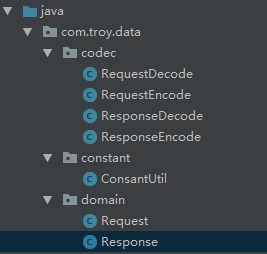netty之编解码
1、netty的编码和解码,在数据传输的时候,考虑数据安全,数据完整性都是很有必要的。这里主要是介绍netty3和netty5的编解码方式。其实从StringEncoder和StringDecoder中也可以获取源码的编解码规则。然后改变成自己的编解码规则也是可以的。
2、netty3和netty5的编解码方式还是存在一定差别的。个人感觉netty5来的更加实用和方便。
3、netty3的编解码规则
1)数据编码规则(我这里只是用于显示,数据规则很简单)
包头+模块+数据(请求编解码)
包头+模块+状态+数据(响应编解码)
2)目录

3)请求和相应对象
package com.troy.data.domain; //请求数据
public class Request { //模块类型
private int model;
//数据
private byte[] data; public int getModel() {
return model;
} public void setModel(int model) {
this.model = model;
} public byte[] getData() {
return data;
} public void setData(byte[] data) {
this.data = data;
} @Override
public String toString() {
return "Request{" +
"model=" + model +
", data=" + new String(data) +
'}';
}
}
package com.troy.data.domain; import java.util.Arrays; //响应数据
public class Response { //模块类型
private int model;
//状态码
private int status;
//数据
private byte[] data; public int getModel() {
return model;
} public void setModel(int model) {
this.model = model;
} public int getStatus() {
return status;
} public void setStatus(int status) {
this.status = status;
} public byte[] getData() {
return data;
} public void setData(byte[] data) {
this.data = data;
} @Override
public String toString() {
return "Response{" +
"model=" + model +
", status=" + status +
", data=" + new String(data) +
'}';
}
}
4)常量(这里的包头,因为是固定的就写了一个常量)
package com.troy.data.constant; //常量
public class ConsantUtil { //固定常量用于数据拼接,确认
public static final int PACKAGE_HEADER = -; }
5)请求编解码
package com.troy.data.codec; import com.troy.data.constant.ConsantUtil;
import com.troy.data.domain.Request;
import org.jboss.netty.buffer.ChannelBuffer;
import org.jboss.netty.buffer.ChannelBuffers;
import org.jboss.netty.channel.Channel;
import org.jboss.netty.channel.ChannelHandlerContext;
import org.jboss.netty.handler.codec.oneone.OneToOneEncoder; public class RequestEncode extends OneToOneEncoder { protected Object encode(ChannelHandlerContext channelHandlerContext, Channel channel, Object o) throws Exception { Request request = (Request) o;
ChannelBuffer channelBuffer = ChannelBuffers.dynamicBuffer();
channelBuffer.writeInt(ConsantUtil.PACKAGE_HEADER);
channelBuffer.writeInt(ConsantUtil.PACKAGE_HEADER);
channelBuffer.writeBytes(request.getData());
return channelBuffer;
}
}
package com.troy.data.codec; import com.troy.data.constant.ConsantUtil;
import com.troy.data.domain.Request;
import org.jboss.netty.buffer.ChannelBuffer;
import org.jboss.netty.channel.Channel;
import org.jboss.netty.channel.ChannelHandlerContext;
import org.jboss.netty.handler.codec.oneone.OneToOneDecoder; //请求数据解码
public class RequestDecode extends OneToOneDecoder { protected Object decode(ChannelHandlerContext channelHandlerContext, Channel channel, Object o) throws Exception {
ChannelBuffer channelBuffer = (ChannelBuffer) o;
if (ConsantUtil.PACKAGE_HEADER == channelBuffer.readInt()) {
Request request = new Request();
request.setModel(channelBuffer.readInt());
byte[] bytes = new byte[channelBuffer.readableBytes()];
channelBuffer.readBytes(bytes);
request.setData(bytes);
return request;
}
return null;
}
}
6)响应编解码
package com.troy.data.codec; import com.troy.data.constant.ConsantUtil;
import com.troy.data.domain.Response;
import org.jboss.netty.buffer.ChannelBuffer;
import org.jboss.netty.buffer.ChannelBuffers;
import org.jboss.netty.channel.Channel;
import org.jboss.netty.channel.ChannelHandlerContext;
import org.jboss.netty.handler.codec.oneone.OneToOneEncoder; //响应编码器
public class ResponseEncode extends OneToOneEncoder { protected Object encode(ChannelHandlerContext channelHandlerContext, Channel channel, Object o) throws Exception {
Response response = (Response) o;
ChannelBuffer channelBuffer = ChannelBuffers.dynamicBuffer();
channelBuffer.writeInt(ConsantUtil.PACKAGE_HEADER);
channelBuffer.writeInt(response.getModel());
channelBuffer.writeInt(response.getStatus());
channelBuffer.writeBytes(response.getData());
return channelBuffer;
}
}
package com.troy.data.codec; import com.troy.data.constant.ConsantUtil;
import com.troy.data.domain.Response;
import org.jboss.netty.buffer.ChannelBuffer;
import org.jboss.netty.channel.Channel;
import org.jboss.netty.channel.ChannelHandlerContext;
import org.jboss.netty.handler.codec.oneone.OneToOneDecoder; //响应解码
public class ResponseDecode extends OneToOneDecoder{ protected Object decode(ChannelHandlerContext channelHandlerContext, Channel channel, Object o) throws Exception {
ChannelBuffer channelBuffer = (ChannelBuffer) o;
if (ConsantUtil.PACKAGE_HEADER == channelBuffer.readInt()) {
Response response = new Response();
response.setModel(channelBuffer.readInt());
response.setStatus(channelBuffer.readInt());
byte[] bytes = new byte[channelBuffer.readableBytes()];
channelBuffer.readBytes(bytes);
response.setData(bytes);
return response;
}
return null;
}
}
7)设置对应的管道编解码就可以了
a、客户端
//设置管道工厂
clientBootstrap.setPipelineFactory(new ChannelPipelineFactory() { public ChannelPipeline getPipeline() throws Exception {
ChannelPipeline channelPipeline = Channels.pipeline();
channelPipeline.addLast("decode",new RequestEncode());
channelPipeline.addLast("encode",new ResponseDecode());
channelPipeline.addLast("client",new ClientHandler());
return channelPipeline;
}
});
@Override
public void messageReceived(ChannelHandlerContext ctx, MessageEvent e) throws Exception {
Response response = (Response) e.getMessage();
System.out.println(response.toString());
super.messageReceived(ctx, e);
}
b、服务端
//设置管道流
serverBootstrap.setPipelineFactory(new ChannelPipelineFactory() { public ChannelPipeline getPipeline() throws Exception {
ChannelPipeline channelPipeline = Channels.pipeline();
//添加处理方式
channelPipeline.addLast("idle",new IdleStateHandler(new HashedWheelTimer(),,,));
channelPipeline.addLast("decode",new RequestDecode());
channelPipeline.addLast("encode",new ResponseEncode());
channelPipeline.addLast("server",new ServerHandler());
return channelPipeline;
}
});
@Override
public void messageReceived(ChannelHandlerContext ctx, MessageEvent e) throws Exception {
Request request = (Request) e.getMessage();
System.out.println("client:"+request.toString());
Response response = new Response();
response.setModel();
response.setStatus();
response.setData("hello client".getBytes());
ctx.getChannel().write(response);
super.messageReceived(ctx, e);
}
4、netty5的编解码规则
1)数据结构、目录结构、对象、常量都是一样。
2)编解码的编写方式有些不一样
a、请求编解码
package com.troy.data.codec; import com.troy.data.constant.ConsantUtil;
import com.troy.data.domain.Request;
import io.netty.buffer.ByteBuf;
import io.netty.buffer.Unpooled;
import io.netty.channel.ChannelHandler;
import io.netty.channel.ChannelHandlerContext;
import io.netty.handler.codec.MessageToMessageEncoder; import java.util.List;
@ChannelHandler.Sharable
public class RequestEncode extends MessageToMessageEncoder<Request> { protected void encode(ChannelHandlerContext channelHandlerContext, Request request, List<Object> list) throws Exception {
ByteBuf byteBuf = Unpooled.buffer();
byteBuf.writeInt(ConsantUtil.PACKAGE_HEADER);
byteBuf.writeInt(request.getModel());
byteBuf.writeBytes(request.getData());
list.add(byteBuf);
}
}
package com.troy.data.codec; import com.troy.data.constant.ConsantUtil;
import com.troy.data.domain.Request;
import io.netty.buffer.ByteBuf;
import io.netty.channel.ChannelHandler;
import io.netty.channel.ChannelHandlerContext;
import io.netty.handler.codec.MessageToMessageDecoder; import java.util.List; //请求数据解码
@ChannelHandler.Sharable
public class RequestDecode extends MessageToMessageDecoder<ByteBuf>{ protected void decode(ChannelHandlerContext channelHandlerContext, ByteBuf byteBuf, List<Object> list) throws Exception {
if (ConsantUtil.PACKAGE_HEADER == byteBuf.readInt()) {
//当数据超过指定值的时候跳过这部分数据
if (byteBuf.readableBytes() > ) {
byteBuf.skipBytes(byteBuf.readableBytes());
}
//一个字节一个字节的读取,知道读取到包头
while(true) {
byteBuf.markReaderIndex();
if (ConsantUtil.PACKAGE_HEADER == byteBuf.readInt()) {
break;
}
byteBuf.resetReaderIndex();
byteBuf.readByte();
}
Request request = new Request();
request.setModel(byteBuf.readInt());
byte[] bytes = new byte[byteBuf.readableBytes()];
byteBuf.readBytes(bytes);
request.setData(bytes);
list.add(request);
}
}
}
b、响应编解码
package com.troy.data.codec; import com.troy.data.constant.ConsantUtil;
import com.troy.data.domain.Response;
import io.netty.buffer.ByteBuf;
import io.netty.buffer.Unpooled;
import io.netty.channel.ChannelHandler;
import io.netty.channel.ChannelHandlerContext;
import io.netty.handler.codec.MessageToMessageEncoder; import java.util.List; //响应编码器
@ChannelHandler.Sharable
public class ResponseEncode extends MessageToMessageEncoder<Response> { protected void encode(ChannelHandlerContext channelHandlerContext, Response response, List<Object> list) throws Exception {
ByteBuf byteBuf = Unpooled.buffer();
byteBuf.writeInt(ConsantUtil.PACKAGE_HEADER);
byteBuf.writeInt(response.getModel());
byteBuf.writeInt(response.getStatus());
byteBuf.writeBytes(response.getData());
list.add(byteBuf);
}
}
package com.troy.data.codec; import com.troy.data.constant.ConsantUtil;
import com.troy.data.domain.Response;
import io.netty.buffer.ByteBuf;
import io.netty.channel.ChannelHandler;
import io.netty.channel.ChannelHandlerContext;
import io.netty.handler.codec.MessageToMessageDecoder; import java.util.List; //响应解码
@ChannelHandler.Sharable
public class ResponseDecode extends MessageToMessageDecoder<ByteBuf>{ protected void decode(ChannelHandlerContext channelHandlerContext, ByteBuf byteBuf, List<Object> list) throws Exception {
if (ConsantUtil.PACKAGE_HEADER == byteBuf.readInt()) {
//当数据超过指定值的时候跳过这部分数据
if (byteBuf.readableBytes() > ) {
byteBuf.skipBytes(byteBuf.readableBytes());
}
//一个字节一个字节的读取,知道读取到包头
while(true) {
byteBuf.markReaderIndex();
if (ConsantUtil.PACKAGE_HEADER == byteBuf.readInt()) {
break;
}
byteBuf.resetReaderIndex();
byteBuf.readByte();
}
Response response = new Response();
response.setModel(byteBuf.readInt());
response.setStatus(byteBuf.readInt());
byte[] bytes = new byte[byteBuf.readableBytes()];
byteBuf.readBytes(bytes);
response.setData(bytes);
list.add(response);
}
}
}
3)处理上面基本上都是一样的。
5、netty的编解码,主要目的就是处理通讯问题,对数据进行自定义处理!
6、源码下载:https://pan.baidu.com/s/1nvUnmEt
netty之编解码的更多相关文章
- Netty入门系列(3) --使用Netty进行编解码的操作
前言 何为编解码,通俗的来说,我们需要将一串文本信息从A发送到B并且将这段文本进行加工处理,如:A将信息文本信息编码为2进制信息进行传输.B接受到的消息是一串2进制信息,需要将其解码为文本信息才能正常 ...
- java架构之路-(netty专题)netty的编解码(出入战)与粘包拆包
上次回归: 上次博客我们主要说了netty的基本使用,都是一些固定的模式去写的,我们只需要关注我们的拦截器怎么去写就可以了,然后我们用我们的基础示例,改造了一个简单的聊天室程序,可以看到内部加了一个S ...
- Netty 编解码技术 数据通信和心跳监控案例
Netty 编解码技术 数据通信和心跳监控案例 多台服务器之间在进行跨进程服务调用时,需要使用特定的编解码技术,对需要进行网络传输的对象做编码和解码操作,以便完成远程调用.Netty提供了完善,易扩展 ...
- Netty 源码 ChannelHandler(四)编解码技术
Netty 源码 ChannelHandler(四)编解码技术 Netty 系列目录(https://www.cnblogs.com/binarylei/p/10117436.html) 一.拆包与粘 ...
- 【转】Netty系列之Netty编解码框架分析
http://www.infoq.com/cn/articles/netty-codec-framework-analyse/ 1. 背景 1.1. 编解码技术 通常我们也习惯将编码(Encode)称 ...
- Netty系列之Netty编解码框架分析
1. 背景 1.1. 编解码技术 通常我们也习惯将编码(Encode)称为序列化(serialization),它将对象序列化为字节数组,用于网络传输.数据持久化或者其它用途. 反之,解码(Decod ...
- netty源码解解析(4.0)-19 ChannelHandler: codec--常用编解码实现
数据包编解码过程中主要的工作就是:在编码过程中进行序列化,在解码过程中从Byte流中分离出数据包然后反序列化.在MessageToByteEncoder中,已经解决了序列化之后的问题,ByteToMe ...
- Netty对常用编解码的支持
参考文献:极客时间傅健老师的<Netty源码剖析与实战>Talk is cheap.show me the code! Netty对编解码的支持 打开Netty的源码,它对很多的编码器都提 ...
- Netty 编解码奥秘
Netty中编解码 Netty 的解码器有很多种,比如基于长度的,基于分割符的,私有协议的.但是,总体的思路都是一致的. 拆包思路:当数据满足了 解码条件时,将其拆开.放到数组.然后发送到业务 han ...
随机推荐
- 关于HiddenHttpMethodFilter
这个类的代码比较少,所以把整个类的代码都复制过来.在注释中添加上自己的理解. public class HiddenHttpMethodFilter extends OncePerRequestFil ...
- Python 输出中文的笔记
import sysreload(sys)sys.setdefaultencoding('utf8') 导入csv乱码: 加入: import codecs csvfile.write(codecs. ...
- sql的寫法,推薦的寫法,全文索引提高類似like查詢的效率
說明:logistics_detail表中每個deliver_id可能對應多個loginticsType,但是我們只要獲取最大的那一個. SELECT dm.delivery_code,dm.deli ...
- python-使用递归实现二分法
在上一篇中简单介绍了递归的使用,请戳这里 . 在此篇中,主要介绍如何用递归实现二分法. 在使用二分法之前,首先要有个前提,那就是这个数组必须是有序数组.主要的思路为: ①先取出数组中的一个中间值, ...
- Collections.synchronizedList线程安全性陷阱
摘要: 详细的解析:Collections.synchronizedList 1 :关注要点,为什么在有synchroniezed方法的同时会出现 Collections.synchronizedLi ...
- PAT——1010. 一元多项式求导
设计函数求一元多项式的导数.(注:xn(n为整数)的一阶导数为n*xn-1.) 输入格式:以指数递降方式输入多项式非零项系数和指数(绝对值均为不超过1000的整数).数字间以空格分隔. 输出格式:以与 ...
- javascript中filter方法
array1.filter(callbackfn[, thisArg]) 參數 參數 定義 array1 必要項. 陣列物件. callbackfn 必要項. 最多接受三個引數的函式. filte ...
- EF Core 2.1 中的 Eager loading、Explicit loading和LazyLoading (转自MSDN)
Entity Framework Core allows you to use the navigation properties in your model to load related enti ...
- JAVA并发-线程状态
一.线程基本状态 新建:线程已创建但start()方法还没执行 就绪(可运行):start()方法已运行,但还没被选择 运行:从就绪线程中选择出某一个线程进行run()操作 阻塞(不可运行):线程正在 ...
- SpringBoot自动装配的原理
1.SpringApplication.run(AppConfig.class,args);执行流程中有refreshContext(context);这句话. 2.refreshContext(co ...
